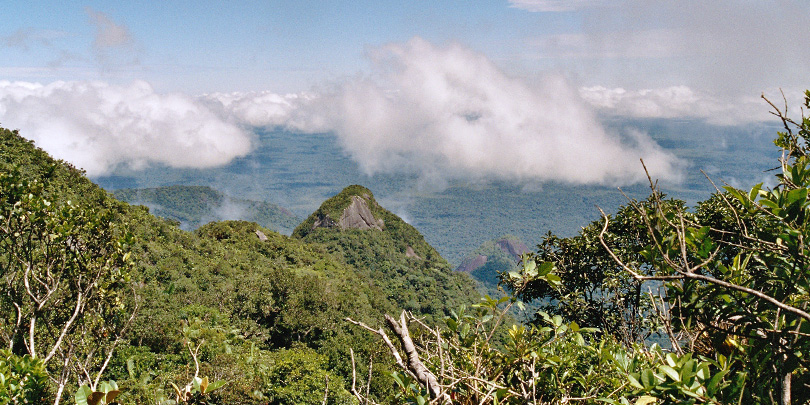Itinerary Days 1-4
Some of our Highlights:
- In dug-out canoes on the Rio Negro and its tributaries hikes and camps along the Curicuriari river
- Rainforest trekking far off the beaten tracks discoveries in the deep rainforest
- Visiting native tribes and congregate with them
- Exploring the big, medium, small, and smaller rivers; silent canoe rides on igarapés and tributaries
- Wildlife observation
- Introduction to the Amazonian rainforest flora and the planets greatest biodiversity
- Survival technics
Itinerary
Day 1
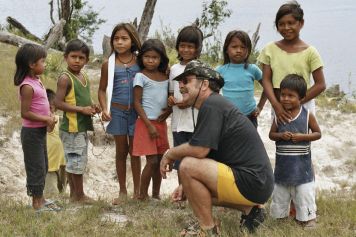 Arrival at São Gabriel da Cachoeira. Pick-up and presentation to guides. We need to get the permit to visit Indian territory and reservations before we board our motorized dog-out canoe. Masterfully steered by our guides, we pass the strong currents and treacherous rapids near São Gabriel da Cachoeira. After roughly 2 hours of traveling on the Rio Negro downstream we reach the Indian settlement São Jorge located at the mouth of the Rio Curicuriari. We will be welcomed by the tribe members of the linguistic group of the Tukano. After introductions and handing over of a gift to the "captain", how the chief is called here, we will be shown around the village. After the short stay at São Jorge we will continue our journey now upstream Rio Curicuriari reaching after 3 hours Camp 1, the Tumbiara Indian village. While traveling on the river we would stop for foto shooting and observations of fauna and flora of the rainforest. Since you will be tired from the trip you will enjoy your first dinner and hammock overnight in the rainforest.
Arrival at São Gabriel da Cachoeira. Pick-up and presentation to guides. We need to get the permit to visit Indian territory and reservations before we board our motorized dog-out canoe. Masterfully steered by our guides, we pass the strong currents and treacherous rapids near São Gabriel da Cachoeira. After roughly 2 hours of traveling on the Rio Negro downstream we reach the Indian settlement São Jorge located at the mouth of the Rio Curicuriari. We will be welcomed by the tribe members of the linguistic group of the Tukano. After introductions and handing over of a gift to the "captain", how the chief is called here, we will be shown around the village. After the short stay at São Jorge we will continue our journey now upstream Rio Curicuriari reaching after 3 hours Camp 1, the Tumbiara Indian village. While traveling on the river we would stop for foto shooting and observations of fauna and flora of the rainforest. Since you will be tired from the trip you will enjoy your first dinner and hammock overnight in the rainforest.
Day 2
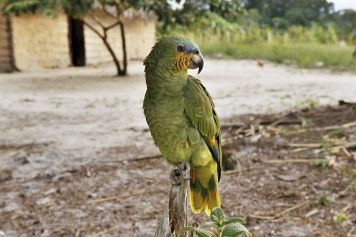 The Indian comunities on the upper Rio Negro bassin are organized and coordinated by ACIBRN, where members of the tribes decide issues of common interest, making sure that traditions and values are maintained and civil rights to which the tribes are entitled being respected.
The Indian comunities on the upper Rio Negro bassin are organized and coordinated by ACIBRN, where members of the tribes decide issues of common interest, making sure that traditions and values are maintained and civil rights to which the tribes are entitled being respected.
As in the old days, before they were "civilized" by catholic missionaries in the late 18th century, natives of the region still use hand-made tools in their everyday lives, e.g. manioc grinders and shakers. Manioc and fish provides most of the diet of the Tukano people, although they also plant bananas and harvest Brazil nuts to trade for beans, rice and medical supplies. The traditional buildings here are made from sticks and clay with wild açaí palm leaf thatched roofs, held together with cipó vines. The tribe members usually are physically healthy and in good shape. The Tumbiara village looks neat, well organised and structured.
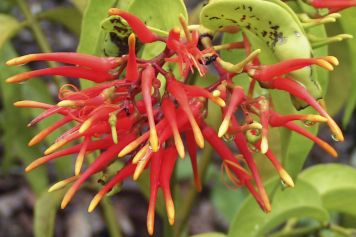 After breakfast we will take the canoe to discover hidden secrets of the igarapé, how the temporily flooded areas are called. These smaller rivers and their surroundings are home to wildlife including Giant otters, Anakondas, and a variety of monkeys. With the help of ur guides we are going to catch delicious fish for lunch. If lucky we get tucunaré or tambaqui on the hook. After lunch and siesta the forest invites for a stroll.
After breakfast we will take the canoe to discover hidden secrets of the igarapé, how the temporily flooded areas are called. These smaller rivers and their surroundings are home to wildlife including Giant otters, Anakondas, and a variety of monkeys. With the help of ur guides we are going to catch delicious fish for lunch. If lucky we get tucunaré or tambaqui on the hook. After lunch and siesta the forest invites for a stroll.
The overwhelming plantlife includes millions of species many of them still unknown to science. Our guides identify for you medical plants of the Amazon without them modern medicine would not be possible.
It is time now to take the canoe for our ride back to the village, where the guides prepare dinner at the open fireplace. The day was long and full of action, but the hammocks are ready for you and the sounds of the jungle eases you into sleep.
Day 3
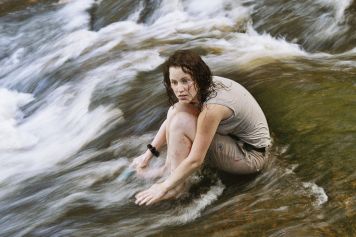 After our jungle breakfast we drive downstream Rio Curicuriari until we reach the trail leading to the clay lick “paredão das araras”. An about 3 hours ride carries us to the Rio Cariuá where we pitch our camp near the Piranhauara waterfall. Here, a resfreshing bath is what we want. Besides, the lush area around the waterfall offers plenty opportunities for taking great pictures. From here we hike the old trail used by the natives to carry huge quantities of Piaçaba thatch extracted from Attalea funifera and Leopoldinia piassaba palms and exported to all parts of Brazil. Our guides show us how this thatch was harvested and taken to the river. The will also show us how to buid a shelter from palm leafs in a fraction of time. Back at the camp we relax in our hammocks while the guides prepared the dinner. With the fire still burning we chat about our first impressions in this amazing and unknown environment called Amazonia.
After our jungle breakfast we drive downstream Rio Curicuriari until we reach the trail leading to the clay lick “paredão das araras”. An about 3 hours ride carries us to the Rio Cariuá where we pitch our camp near the Piranhauara waterfall. Here, a resfreshing bath is what we want. Besides, the lush area around the waterfall offers plenty opportunities for taking great pictures. From here we hike the old trail used by the natives to carry huge quantities of Piaçaba thatch extracted from Attalea funifera and Leopoldinia piassaba palms and exported to all parts of Brazil. Our guides show us how this thatch was harvested and taken to the river. The will also show us how to buid a shelter from palm leafs in a fraction of time. Back at the camp we relax in our hammocks while the guides prepared the dinner. With the fire still burning we chat about our first impressions in this amazing and unknown environment called Amazonia.
Day 4
Hike to Macaws and Parrots Clay Lick
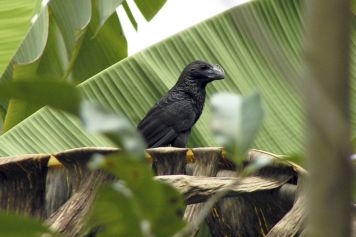 The hikers among us have the saying today. The destination is the parrots and macaws clay lick, requiring a jungle hike of some 8 hours. During regular breaks we observe the area around us and watch how the guides extract fresh water from lianas or identify medical plants like quinine, xixuá Maytenus Guyanensis Klotzch a biotonic and estimulant or Copaiba oil Copaifera sp., a powerful antibiotic.
The hikers among us have the saying today. The destination is the parrots and macaws clay lick, requiring a jungle hike of some 8 hours. During regular breaks we observe the area around us and watch how the guides extract fresh water from lianas or identify medical plants like quinine, xixuá Maytenus Guyanensis Klotzch a biotonic and estimulant or Copaiba oil Copaifera sp., a powerful antibiotic.
We learn about the Amazonian rainforest and will respect this unique environment as an inexaustible provider of medicine. Our camp is pitched near the clay lick. The long hike takes certainly its toll and after the hungry mouth are plugged everybody hits the hammocks with relief.
Day 5
Macaws and Parrots Clay Lick - Paradeão das Araras
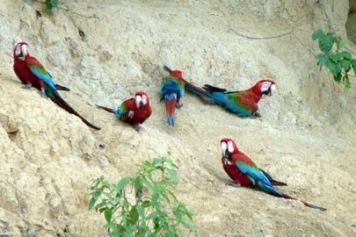 Our guide Alberto discovered the clay wall on one of his jungle explorations. Hidden in the dense forest ony a few natives know its location. There is plenty of time to watch and photograph several species of parrots and the colourful macaws like the yellow-breasted Ara ararauna and green-winged Ara chloroptera when they supply their need for minerals at the wall, otherwise not available in the forest. The constant arrival and departure of the birds provides a lively and colorful spectacle. Since today's digital cameras offer no or little limit you may click away to choose the best shots for your photo album of memories when back home. Return o the camp for overnight.
Our guide Alberto discovered the clay wall on one of his jungle explorations. Hidden in the dense forest ony a few natives know its location. There is plenty of time to watch and photograph several species of parrots and the colourful macaws like the yellow-breasted Ara ararauna and green-winged Ara chloroptera when they supply their need for minerals at the wall, otherwise not available in the forest. The constant arrival and departure of the birds provides a lively and colorful spectacle. Since today's digital cameras offer no or little limit you may click away to choose the best shots for your photo album of memories when back home. Return o the camp for overnight.
Day 6
Expedition, Camp Arabú (Lage)
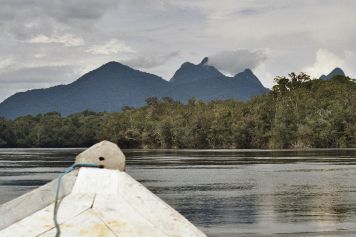 After breakfast we break down the camp and take the trail back to Cariuá Igarapé, where we anchored our canoe. We travel the Cariuá downstream to enter the Curicuriari river taking us to the starting point of the trail leading to the Bela Adormecida or “Sleeping Beauty” hill.
After breakfast we break down the camp and take the trail back to Cariuá Igarapé, where we anchored our canoe. We travel the Cariuá downstream to enter the Curicuriari river taking us to the starting point of the trail leading to the Bela Adormecida or “Sleeping Beauty” hill.
At Arabu igarapé a small waterfall invites for a refreshing shower. This is also the ideal place for our camp for the night. At camp site our guides prepare a drink from saracura mirá roots (Ampelozizyphus amazonicus Ducke) that cleanses all the organs in the body and isalso used to relief chest pains. It is also recommended against malaria. This is a quite a lengthy process which begins with scraping the shavings of roots into a pan, adding water and whisking vigorously with a split root that replaces the whirl, until it foams. After this the foam is scraped off before repeating the method another four times and then drinking the mixture which has a bitter taste, but improves the more you drink! The guides who carry all the equipment and food all the way in their yamanchis, the natives pack-pack, vow for the drink as it relieves their chest pain. After dinner we set out for a night walk into the forest. With the help of our flash lights we watch night life in the jungle including nocturnal animals. Since the jaguar is also a nocturnal hunter the hope is not to have a close encounter with this magnificent cat.
Day 7
Expedition, Trail to Sleeping Beauty hill
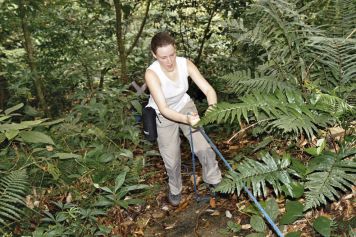 A 4 hours hike through dense rainforest takes us to the foothills of the “Sleeping Beauty”, where we mount our camp. The mountain's contoures resemble those of a sleeping woman, hence its name.
A 4 hours hike through dense rainforest takes us to the foothills of the “Sleeping Beauty”, where we mount our camp. The mountain's contoures resemble those of a sleeping woman, hence its name.
For the rest of the day we explore the area around the camp and with the help of our knowledgable guides trying to identify some of the plantlife around us. Epiphytes like bromeliads and orchids, endemic to the region, will catch our attention. To the interested nature photographer they are most attractive especially when in flower. Perhaps you discover the chocolate scented Braemia vittata which opens its bulb beginning of November, or you may marvel at the yellow Octomeria grandi-flora unfolding its colors in short intervals between end February and beginning of March. As tomorrows hike to the peak of “Sleeping Beauty” requires to be in good shape early and a good amount of sleep is recommended. Not before however, we have enjoyed our jungle dinner our guides have cooked for us.
Day 8
Ascent to the top of the Sleeping Beauty
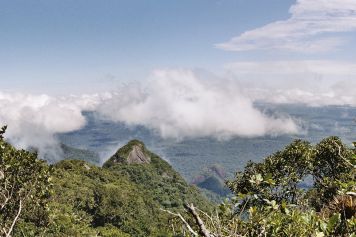 This morning we are heading for the top of the "Sleeping Beauty”. After approximately 4 hours exhausting uphill hike the group arrives at the ridge of the mountain. Time to take a breath and get prepared for a short climb to the summit. While this climb does not require technical expertise in mountaineering a rope is needed to support your efforts to get to the top. The views from here are breathtaking, with the Amazonian rainforest stretched out below us like a blanket. At 1,125 m above sea level, we can identify some of the places we have passed by so far, including São Gabriel da Cachoeira, the port of Camanaus, the Rio Negro and the Curicuriari as well as the São Jorge community. We stay on the summit for a good while, enjoying amazing vistas with great photo opportunities.
This morning we are heading for the top of the "Sleeping Beauty”. After approximately 4 hours exhausting uphill hike the group arrives at the ridge of the mountain. Time to take a breath and get prepared for a short climb to the summit. While this climb does not require technical expertise in mountaineering a rope is needed to support your efforts to get to the top. The views from here are breathtaking, with the Amazonian rainforest stretched out below us like a blanket. At 1,125 m above sea level, we can identify some of the places we have passed by so far, including São Gabriel da Cachoeira, the port of Camanaus, the Rio Negro and the Curicuriari as well as the São Jorge community. We stay on the summit for a good while, enjoying amazing vistas with great photo opportunities.
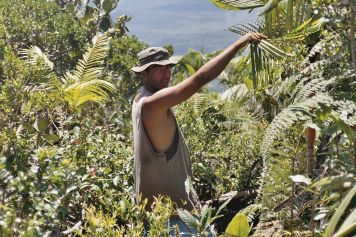 The descent is much tougher on the knees than ascending. We safely negotiate the obstacles in our way back to the camp (e. g. the vertical sections, hornets nests and snakes like the non poisonous smooth machete savanne or Rusty whip snake, here called cobra cipó, which is common in the primary Amazonian forest). Back at the camp we are ready for nothing else except for a delicious meal that has been cooked to perfection while we have been away, followed by a crawl into our hammocks to rest up after a full day of exertion. The "Sleeping Beauty" of the Amazon is (in our opinion) one of the best daylong ascents/descents trekking to be found anywhere and is a must see for non-technical mountaineers and hikers alike.
The descent is much tougher on the knees than ascending. We safely negotiate the obstacles in our way back to the camp (e. g. the vertical sections, hornets nests and snakes like the non poisonous smooth machete savanne or Rusty whip snake, here called cobra cipó, which is common in the primary Amazonian forest). Back at the camp we are ready for nothing else except for a delicious meal that has been cooked to perfection while we have been away, followed by a crawl into our hammocks to rest up after a full day of exertion. The "Sleeping Beauty" of the Amazon is (in our opinion) one of the best daylong ascents/descents trekking to be found anywhere and is a must see for non-technical mountaineers and hikers alike.
Day 9
Expedition, Return to Igarapé Lage
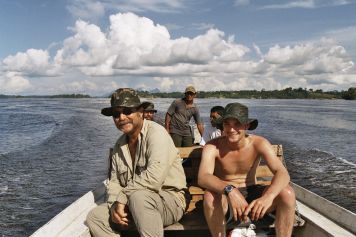 Our trekking today brings us back to the Igarape lage, where we moored our canoe. On route we marvel at giant buttress root kapok trees Ceiba petandra in Brazil called Samauma, that can reach up to 200 ft high. This last night in the forest we will stay at the tukano village of São Jorge. Depending on the remaining fuel, the expedition leader might take the canoe to a nearby port and pick up a few well-earned cold beers to enjoy on our last night in the jungle. We have arranged for a good bye party with the natives during which they will present us with traditional dances of the tribe. After stories around fire place, the party settle down to their last night in hammocks – that king size back home seems a long way away and you wonder if you'll ever get used to it again?...the traffic… closing times at the pubs... perhaps I'll just stay a while longer...
Our trekking today brings us back to the Igarape lage, where we moored our canoe. On route we marvel at giant buttress root kapok trees Ceiba petandra in Brazil called Samauma, that can reach up to 200 ft high. This last night in the forest we will stay at the tukano village of São Jorge. Depending on the remaining fuel, the expedition leader might take the canoe to a nearby port and pick up a few well-earned cold beers to enjoy on our last night in the jungle. We have arranged for a good bye party with the natives during which they will present us with traditional dances of the tribe. After stories around fire place, the party settle down to their last night in hammocks – that king size back home seems a long way away and you wonder if you'll ever get used to it again?...the traffic… closing times at the pubs... perhaps I'll just stay a while longer...
Day 10
Return São Jorge community - São Gabriel da Cachoeira
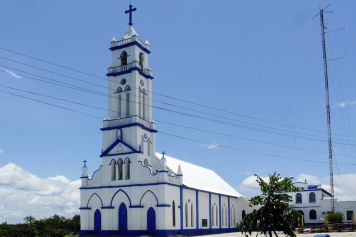 Packing up the gear and saying good bye to our Tucano friends is on the plan today. We arrive back in São Gabriel da Cachoeira before lunch time and check-in the “Deus me deu” hotel. There will be a hot shower waiting for you, if that is what you long for. Use the afternoon to get your baggage cleaned and prepared for the flight to Manaus and further. I also recommend a stroll through the border town and visit to the FOIRN community centre where you can purchase beautiful handicraft from yanomami and other tribes of the upper Rio Negro basin. A last dinner with your guides at a local Restaurant with some caipirinhas to go along will certainly contribute to forget the “hardships” of the past 10 days only to remember awesome experiences and fun in the Amazonian rainforest.
Packing up the gear and saying good bye to our Tucano friends is on the plan today. We arrive back in São Gabriel da Cachoeira before lunch time and check-in the “Deus me deu” hotel. There will be a hot shower waiting for you, if that is what you long for. Use the afternoon to get your baggage cleaned and prepared for the flight to Manaus and further. I also recommend a stroll through the border town and visit to the FOIRN community centre where you can purchase beautiful handicraft from yanomami and other tribes of the upper Rio Negro basin. A last dinner with your guides at a local Restaurant with some caipirinhas to go along will certainly contribute to forget the “hardships” of the past 10 days only to remember awesome experiences and fun in the Amazonian rainforest.
Day 11
We will transfer you to the airport to catch the flight to Manaus. This is the end of our services for the Rio Negro Rainforest Experience. If you wish to book one of our other activities in Brazil or need our help otherwise, please let us know. We will be pleased to assist you.
Guest Comments
Guest Comments
Jean Scheurer, Switzerland
To start my trip, I spent 3 exciting days in Rio. My guide Gean from Southern Cross Tours & Expditions (SCTE) was very kind and shared with me all his knowledge about his city – a real pleasure to discover this vibrant megalopolis with him.
At my arrival in Manaus, I was picked up by SCTE-Guide Wilmar, who then took me to the Hotel do Largo. He organised my stay in Manaus including all transfers and my city tour. I went to see the “meeting of the waters” on a boat, in a small group. It is a simply amazing phenomenon – two rivers, both of different colours, meeting without their colours being mixed.
The next day I departed to Novo Airao, 2 ½ hours drive by car, where I boarded the speed boat together with my guides Vermelinho and Frank from the SCTE outpost in the Amazon. We slept in hammocks; the food was prepared on the camp-fire. Our program included nightly excursions in the terra firme forests and the Igarapes(river branches) to observe nocturnal animals such as crocodiles.
We visited a local tribe, the caboclos, and the ruins of an old rubber factory,that reminds of a time when the production of latex was the main driving factor for Brazil’s economic prosperity.
Return to Manaus and flight to Sao Gabriel da Cachoeira. Here I did the expedition“Rio Negro Rainforest Experience” which had caught my attention when reading through the SCTE website. Peter from Southern Cross adapted the expedition according to my wishes, and so we have added a trip to the Amazon mountain “Pedra de Cucui”, on the border to Venezuela, as the first stage of my expedition. Branco, the head-guide from SCTE was waiting for me at the airport. In a speed boat, 70kph, we reached the village Cucui, already in Venezuela, after 5 hours.
The next day we had an early morning start. Accompanied by a soldier who was familiar with the area we entered the jungle. The treks were challenging, we had to climb rocks, holding onto a rope and cross caves full of bats. The humidity and the heat made the trekking hard, but I enjoyed it and Branco was really helpful, adapting the pace according to my needs. Finally we returned to the village, ready for heading back to Sao Gabriel.
We then returned to Sao Gabriel where Thomas from Zurich joined us and together we started our journey to the Bela Adormecida mountain. It was Thomas’ first time in the jungle and just as me he was fascinated by the extreme living conditions there. The complete isolation was hard, but we handled it well. Our guides walked in front of us, opening up the treks with their machete, which turned out to be difficult sometimes, as the vegetation can be very thick there, trunks, lianas and rocks blocking our way. Life in the Amazon is amazing. Cutting down trees, opening treks, and setting up our camps required hours of daily work by our team. They also did a great job in cooking, we ate very well, even though my appetite was very low due to the physical exhaustion. I was very satisfied with our great team, always in a good mood; the only thing I didn’t appreciate was the mosquitoes and other insects bothering us.
I liked being surrounded by 100% nature, listening to the rain falling down on the big leaves of the trees, sleeping in hammocks underneath the stars and so on. Some days we were covered in mud, but there were always small rivers or creeks to take a bath in and to wash our clothes. We went up the river by canoe to see some cataracts, which was simply amazing. Everything a pure adventure!
After our return from the jungle I had a few more days left to explore Manaus with Wilmar. I visited the famous theatre and some other important sights.
Before going home, I went back to Rio to enjoy the Carnaval. The vibrant atmosphere, the shows of the Samba schools, and music everywhere – an incredible experience!
All in all I had an amazing trip, thanks to everyone from Southern Cross Tours & Expedition for the perfect organisation!
Ofer Karliner
I thought the jungle programme was excellent as were the guides. The itinerary was challenging on some days (in part because I arrived late), however the guides were helpful, able to adjust the pace as necessary.
I probably would have enjoyed being a bit more involved in the hunting/fishing and I think it could have enhance the overall programme if we had ‘lived off the land’ a little more. That said, the meals were a good size and for the most part quite good. A bit more time on the survival aspect would have been good too, although once I asked, Branco and Jose made an effort to point out plants etc......
Overall, Gean, Branco and Jose did an outstanding job!
Highlights: The climb, the anaconda, night hunting and Branco’s fish stew (absolutely brilliant).
Lowlights: The village, the mosquitos.
Cheers,
Ofer Karliner
Lynn Strawbridge and Kerry Pucket
It was truly the trip of a life time. Branco is an AMAZING person, he made the trip!!!!!!!! Our porters were FABULOUS!!!!! They made us benches, a shelf for our bags, grass skirts, bracelets... they took such good care of us it was truly unbelievable. Walder was nice as well. Honestly, I can't express how amazing the trip was. It was truly a dream. THANKS to "Amazon Travel Brazil" for giving us this wonderful experience!
Thank you,
Keri and Lynn
Prices & Travel Details
Prices & Travel Details
| Travel Time | 11 days / 10 nights | ||
|---|---|---|---|
| Group Size | minimum 2, maximum 6 participants | ||
| Best Travel Time | This tour is operated from January through December being November-April the best month to travel. | ||
| Price | 4 participants | 4,990 US$ | per person |
| 3 participants | 5,490 US$ | per person | |
| 2 participants | 5,900 US$ | per person | |
| Prices for individuals or larger groups on request | |||
| Note: This price is valid for the surface arrangements only. The flight from Manaus to São Gabriel da Cachoeira v.v. is not included and costs, depending on rate of exchange at the time of booking around 540 US$. | |||
Included
- All transfers
- 1 overnight/breakfast in São Gabriel da Cachoeira
- City hike and stroll in São Gabriel da Cachoeira
- Expedition equipment, canoe, engines, gasoline, hammocks
- Meals
- Guides, carriers
- Permits to enter Indian territories and reservations
- English or English speaking expedition leader
Not Included
- International and domestic flights
(Manaus/São Gabriel da Cachoeira v.v. 300,- €) - Alcoholic beverages
- Gratuities
All necessary documents will be delivered by courier.
Payment and Reservations
Reservations must be made with a minimum of 90 days prior to departure. After receiving our booking confirmation a deposit of 50 % to our German account is due. The rest is payable 30 days prior departure.
Remarks
The hike uphill to the Bela Adormecide mountain requires certain fitness. If you are used to jogg or to hike regularly, than you are in the ideal shape for this adventure.
All participants are expected to coop with each other and to follow instructions given by the leader.
As temperatures vary from permanently well over 30° C during the day, down to around 10° C at night with humidity reaching 90 % and more, clothing should include two set seach of shorts, shirts with long sleeve, light cotton socks, swim wear, several sets of t-shirts and underwear, rain cape, warm clothing for the night. High leather bootlegs with corrugated sole and solid grip are recommended for hiking and solid rubber trekking sandals to ford or bath in creeks, streams...
Equipment: 2 backpacks (70-100/35-50 l) as main baggage is stored in São Gabriel, sleeping bag, thermoflask, binocular, photo equipment, flash light, swiss army knife, personal cutlery, hut, sunglasses, insect repellent.
Only personal belongings (5-8 kg) have to be carried by each participant
Accomodation
Pousada in São Gabriel da Cachoeira, on expedition in prepared camps and hammocks.
Health
Vaccines mandatory: yellow fever, hepatites, tetanus
Vaccines not mandatory: malaria prophylaxis
Drinking Water
From creeks and rapids, using of desinfection products recommended
First Aid
Granted by guides, bring your personal medicine
Communication
Global Star satelite telephone
Meals
Salted, smoked and canned meat, fresh fish, ready made soups,rice, pasta, dehydrated vegetables, crackers, cookies, bisquits, banana and guava sweets, coffee, tea, dry milk
Accomodation
Hotel in Manaus and Pousada in São Gabriel da Cachoeira, on expedition in prepared camps and hammocks
